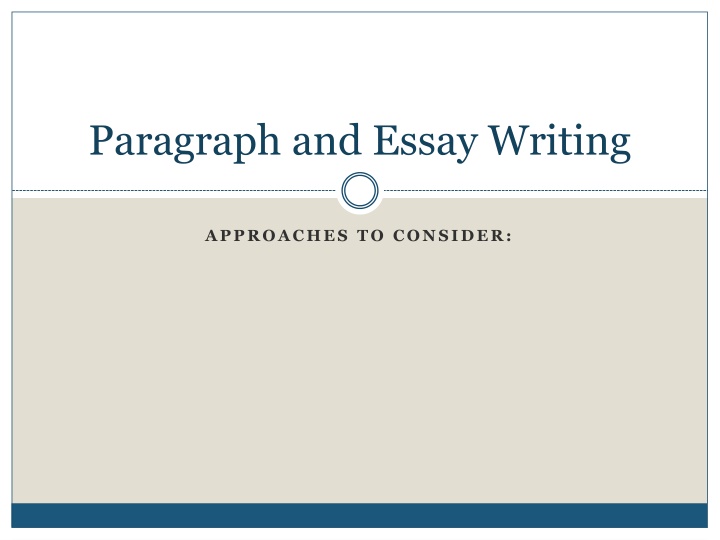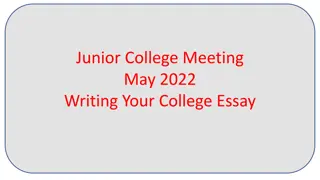Effective Approaches to Paragraph and Essay Writing
Effective writing of paragraphs and essays requires understanding the basic patterns such as the Ancient Pyramid and the Hamburger metaphor. The structure includes a topic sentence, supporting details, and a concluding sentence to ensure clarity and coherence. These same patterns can be extended to writing essays, with an introductory paragraph, supporting paragraphs, and a concluding paragraph forming a well-organized piece of writing.
Download Presentation

Please find below an Image/Link to download the presentation.
The content on the website is provided AS IS for your information and personal use only. It may not be sold, licensed, or shared on other websites without obtaining consent from the author.If you encounter any issues during the download, it is possible that the publisher has removed the file from their server.
You are allowed to download the files provided on this website for personal or commercial use, subject to the condition that they are used lawfully. All files are the property of their respective owners.
The content on the website is provided AS IS for your information and personal use only. It may not be sold, licensed, or shared on other websites without obtaining consent from the author.
E N D
Presentation Transcript
Paragraph and Essay Writing APPROACHES TO CONSIDER:
The Basic Pattern Writing paragraphs and essays can be frustrating if you do not know where to start. There are many graphic organizers that can help you. There is no one right way, but there is a common format that you can use to get started.
Basic Pattern The Ancient Pyramid Topic Sentence helps readers to identify what the paragraph is about Supporting Details (at least one sentence, but two or three are usually better) Concluding Sentence restates the main idea paraphrase the topic sentence
The Same Pattern, But Another Metaphor The Hamburger Topic Sentence Supporting Detail Supporting Detail Supporting Detail Concluding Sentence
Topic Sentence The topic sentence determines the content of the paragraph. The topic sentence must guide readers and capture their attention at the same time. Most paragraphs have their topic sentence as the first sentence, HOWEVER, this is not always the case. Explore your own writing style to see what works for you
Supporting Details Supporting detail sentences are not any less important than topic sentences. They just play a different role. Sentences containing supporting details may contain observations, comments or insights that are relevant to the main idea. They are the meat and potatoes, or, get down to business part of the paragraph.
Concluding Sentence The concluding sentence reinforces the whole paragraph. It does not leave the reader wondering what the paragraph was about. Your readers know for certain what the flavour of the paragraph is. Quite often the concluding sentence in the introductory paragraph in many reports contains an explicit thesis statement.
Essays An Extension of the Same Metaphors The same basic metaphors of the pyramid and hamburger can be applied to writing essays. Essays usually contain an introductory paragraph, at least two or three (minimum) supporting paragraphs, and a concluding paragraph.
Essays and the Pyramid Introductory paragraph: likely contains a thesis statement Supporting paragraphs: Each supporting paragraph provides details, comments or insights for one aspect of the controlling idea Concluding Paragraph: Sums up, or ties loose ends together. Often it restates the thesis in a more interesting way
Super-Sized Hamburger (Essay) Introductory paragraph containing thesis statement Supporting paragraphs: Each addresses only one point of the controlling idea Concluding paragraph sums up the information and restates the thesis.
Thesis Statements The thesis statement or main claim must be debatable An argumentative or persuasive piece of writing must begin with a debatable thesis or claim. In other words, the thesis must be something that people could reasonably have differing opinions on. If your thesis is something that is generally agreed upon or accepted as fact then there is no reason to try to persuade people (OWL, 2013).
Thesis Statements Example of a non-debatable thesis statement: Pollution is bad for the environment Example of a debatable thesis statement: At least 25 percent of the federal budget should be spent on limiting pollution. (Owl, 2013) Discussion point! What makes the second statement debatable while the first is not?
Thesis Statements The thesis needs to be narrow (in focus) Generally the narrower the thesis the more effective your argument will be. Your thesis or claim must be supported by evidence. The broader your claim is, the more evidence you will need to convince readers that your position is right (Owl, 2013).
Thesis Statements Example of a thesis that is too broad: Drug use is detrimental to society. Example of a narrow or focused thesis: Illegal drug use is detrimental because it encourages gang violence. (Owl, 2013) Discussion point! What makes the second statement more focused than the first?
Other methods to consider: Outlining and Mind Mapping (Webbing) Outlining and Mind Mapping (Webbing) are also great ways to organize information before you begin to write. They can often help to sort the information into neatly focused paragraphs. There are many good (and free!) outlining and mind mapping (webbing) apps and websites available to assist you with organizing your writing.
Supporting Paragraphs Each supporting paragraph should tackle only one point of the thesis statement. Think of being a lawyer in a court room how would you defend your thesis if it were on trial? What information could you use to make your point? Are some points more important than others? Is there a logical order to the information you are presenting (If not, there should be!)?
Transitional Devices the Cheese and Mustard that Hold it Together A hamburger that is sloppily put together is difficult to eat. The insides fall out of the bun and make a mess! So it is with the essay. We need to put the essay together so that each part sticks to the other. We do this with transitional devices.
What are Transitional Devices? Transitional devices are words and phrases that link ideas, sentences and paragraphs. They help the essay (or paragraph) flow easily. Words and phrases like: therefore, because, however, albeit, also, in addition to, as a result, furthermore, hence, in conclusion, to reiterate.... What words or phrases have you used, read or heard to help essays and conversations flow?
Lets Write! Take some time to organize your material and your thoughts. Use tools such as outlines and mind maps or webs to help you. Write your first draft. Do not shoot for publication quality in your first draft. If you are using information directly from someone, give them credit. Paraphrase as much information as you can. Make sure you know the difference between paraphrasing and plagiarism
Its a Little Drafty (pardon the pun)! Revise in your second draft. Add material you may have missed, and delete information that has been repeated (unless you are going for repetition as an effect). Edit for spelling, grammar and general flow in your third draft. Polish if necessary in your fourth daft.
Celebrate Congratulations! You are a writer!























